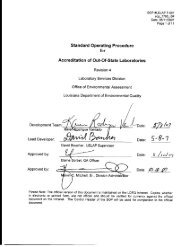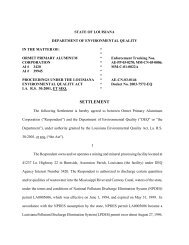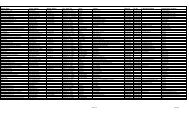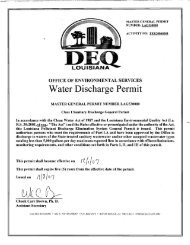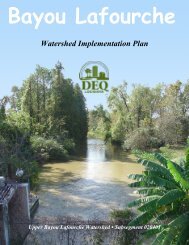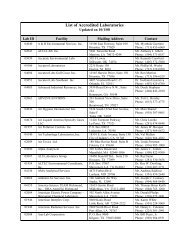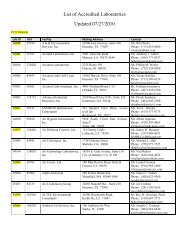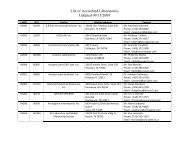UPDATE
UPDATE - Louisiana Department of Environmental Quality
UPDATE - Louisiana Department of Environmental Quality
- No tags were found...
You also want an ePaper? Increase the reach of your titles
YUMPU automatically turns print PDFs into web optimized ePapers that Google loves.
Page 4<br />
Ozone Classification For Greater Baton Rouge<br />
Area Changes From Serious To Severe<br />
Staff of DEQ Environmental Planning Division,<br />
l to r, Sandra Hilton, Vivian Aucoin, Teri Lanoue,<br />
Elizabeth McDearman, back, Ron Rebouche,<br />
Linda Brown, Jennifer Walton, Maurice Oubre,<br />
not pictured Bryan Johnston, James Magee.<br />
Louisiana has made great progress reducing ozone in the last 25 years.<br />
In 1978, there were 20 ozone non-attainment areas in the state.<br />
Presently there is only one. This area, often referred to as the Baton<br />
Rouge non-attainment area, includes Ascension, East and West Baton Rouge,<br />
Iberville and Livingston parishes. The remaining 59 parishes are in attainment<br />
with the ozone standard. There is a range of classifications for non-attainment<br />
areas. These are marginal, moderate, serious, severe and extreme. The Baton<br />
Rouge non-attainment area was<br />
classified as serious. However,<br />
because the area failed to meet<br />
the November 15, 1999 attainment<br />
deadline established<br />
in the Clean Air Act Amendments<br />
of 1990, the Louisiana<br />
Department of Environmental<br />
Quality’s Environmental Planning<br />
Division submitted a revision<br />
to the air quality State<br />
Implementation Plan (SIP) in<br />
December 2001. This plan revision<br />
was based on the Ozone<br />
Transport Guidance Policy set<br />
forth by the Environmental Protection Agency (EPA). This policy afforded the<br />
area an extension of its deadline for attainment to November 15, 2005. A series<br />
of court rulings in cases challenging the EPA transport policy in other areas in<br />
the country led the federal agency to withdraw its approval of the Baton<br />
Rouge attainment date extension. Therefore, because the area did not reach<br />
attainment by the established deadline, and not because air quality worsened,<br />
the five-parish Baton Rouge non-attainment area was “bumped-up” from a<br />
serious classification to severe. This “bump-up” requires citizens living, working<br />
and operating businesses in the five affected parishes to make some<br />
adjustments. These adjustments include:<br />
The area is required to use reformulated gasoline (RFG) which brings with<br />
The 2003 ozone season will be of the utmost importance to this area.<br />
Because the five-parish ozone non-attainment area has been reclassified from<br />
serious to severe, a collaborative effort to control ozone formation will be critical.<br />
Ozone season runs from May 1st to September 30th. Business and industry<br />
and even private citizens will need to operate in a manner such that emissions<br />
are diminished during the ozone season. But how?<br />
There are many programs in place to proactively help reduce the ozone<br />
emissions that only require awareness and cooperation from all of Louisiana’s<br />
citizens. One of these programs is the Ozone Action Day Program. Through<br />
this program that has been run by members of the DEQ Environmental<br />
Planning Division for several years, industry and business invite their employees<br />
and family members to do their part in preventing ozone.<br />
Ozone season is that time of year when ground level<br />
ozone, the main ingredient in smog, becomes a problem.<br />
Industry, and the public as well, can work together to<br />
make a difference in the man-made contributions to<br />
ozone. Even small changes to daily routines can help. The<br />
environmental outreach staff of DEQ has developed a<br />
number of tools to help educate the public and to cooperate<br />
with the efforts of industry.<br />
The Ozone Action Program outlines the kind of things<br />
that individuals can do on those hot summer days when the<br />
air is stagnant and ozone formation is likely.<br />
Following are the voluntary steps you can take:<br />
• Maintain your vehicle to minimize pollutant emission.<br />
• Limit daytime driving, combine errands and bring your<br />
lunch to work.<br />
• Refuel your car in the cooler evening hours. Don’t top off<br />
your tank.<br />
• Ride public transportation or carpool to work.<br />
Do you know what this means to you?<br />
it higher gasoline costs.<br />
Enforceable transportation control measures are required to offset the growth<br />
of vehicle miles traveled in the five-parish area. This includes measures such as<br />
employer-based management plans; trip reduction ordinances; provisions of all<br />
forms of high occupancy, shared ride services; and parking management.<br />
The definition of major source is revised from 50 tons per year to 25, and certain<br />
small businesses will have to submit permit applications and be subject to<br />
enforcement, monitoring and reporting. This could include larger bakeries,<br />
some restaurants, fabrication facilities, and small specialty industrial facilities.<br />
Offset requirements for modifications or new construction of major sources<br />
will increase.<br />
If the area fails to reach attainment by November 15, 2005, industries that<br />
are major stationary sources will be assessed fees of up to $5,000.00 per ton<br />
of volatile organic compounds (VOCs). VOCs in the environment contribute<br />
to ozone formation.<br />
In addition, the area will be tagged with the stigma of having a severe air<br />
quality problem when, in accordance to the parameters established for the different<br />
classifications, the air quality in Baton Rouge falls under marginal.<br />
Some of the requirements will start 60 days after the EPA publishes the “bumpup”<br />
notice in the Federal Register. Others will go into effect within a year.<br />
Reducing Ozone Improves Air Quality<br />
Would You Like to Write a Success Story?<br />
Ozone non-attainment parishes<br />
1978 2002<br />
• Don’t mow your lawn or use gas-powered lawn equipment until after 6pm.<br />
A gas-powered lawnmower produces more pollution than 70 new cars.<br />
• Drive emission-wise. Avoid prolonged idling and jackrabbit starts.<br />
• Walk or ride your bicycle for short trips.<br />
• Barbecue with an electric starter, not fluid.<br />
• Postpone oil based solvent and paint use.<br />
• Make sure your gas cap seals.<br />
• Conserve energy in your home.<br />
• Spread the word! Talk to your friends, coworkers and neighbors about the<br />
Ozone Action Day Program.<br />
By following these steps throughout the ozone season, you will help write<br />
the Greater Baton Rouge area success story. The Ozone<br />
Action Day Program stresses the cooperation of individuals<br />
with larger entities such as business and industry. When<br />
the Evaluation Division of DEQ forecasts an OZONE<br />
ALERT, the local news media will broadcast it. DEQ will<br />
notify the Ozone Action Participants and the steps above<br />
should be followed. If a person is sensitive to ozone, outdoor<br />
activities should be limited. The health risk from<br />
ozone is greater to those with heart or lung disease, children<br />
and the elderly. During ozone season, you can keep<br />
informed about the air quality in certain regions of the<br />
state by calling the DEQ Air Quality Hotline at 225-765-<br />
2660 or by logging on to the DEQ website at<br />
www.deq.state.la.us/evaluation/ozone for links to much<br />
more information and websites. You can get daily ozone<br />
forecasts at www.deq.state.la.us/evaluation/ozone/<br />
oz_today.asp.<br />
When you see this poster Stop! Read!! Act!!!



